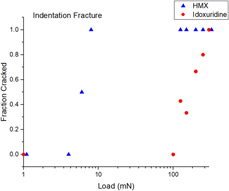Crossref Citations
This article has been cited by the following publications. This list is generated based on data provided by
Crossref.
Burch, Alexandra C.
Wilde, Zakary R.
Bahr, David F.
and
Yeager, John D.
2020.
A Thermal and Nanomechanical Study of Molecular Crystals as Versatile Mocks for Pentaerythritol Tetranitrate.
Crystals,
Vol. 10,
Issue. 2,
p.
126.
Gallagher, Hugh G.
Sherwood, John N.
and
Vrcelj, Ranko M.
2021.
Microhardness Indentation Studies of 2‐4‐6 Trinitrotoluene.
Propellants, Explosives, Pyrotechnics,
Vol. 46,
Issue. 11,
p.
1733.
Gabriele, Benjamin P. A.
Williams, Craig J.
Lauer, Matthias E.
Derby, Brian
and
Cruz-Cabeza, Aurora J.
2021.
Probing anisotropic mechanical behaviour in carbamazepine form III.
CrystEngComm,
Vol. 23,
Issue. 34,
p.
5826.
Herman, Matthew J.
Woznick, Caitlin S.
Scott, Sidney J.
Tisdale, Jeremy T.
Yeager, John D.
and
Duque, Amanda L.
2021.
Composite binder, processing, and particle size effects on mechanical properties of non-hazardous high explosive surrogates.
Powder Technology,
Vol. 391,
Issue. ,
p.
442.
Barr, Christopher M.
Cooper, Marcia
Lechman, Jeremy
and
Bufford, Daniel C.
2021.
The mechanical response of micron-sized molecular crystals.
MRS Advances,
Vol. 6,
Issue. 27,
p.
674.
Schmalbach, Kevin M.
Lin, Albert C.
Bufford, Daniel C.
Wang, Chenguang
Sun, Changquan Calvin
and
Mara, Nathan A.
2021.
Nanomechanical mapping and strain rate sensitivity of microcrystalline cellulose.
Journal of Materials Research,
Vol. 36,
Issue. 11,
p.
2251.
Majumder, Sushmita
Sun, Changquan Calvin
and
Mara, Nathan A.
2022.
Nanomechanical testing in drug delivery: Theory, applications, and emerging trends.
Advanced Drug Delivery Reviews,
Vol. 183,
Issue. ,
p.
114167.
Burch, Alexandra C
Euser, Virginia K
Morrow, Benjamin M
Cady, Carl M
and
Yeager, John D
2022.
Compressive strength of the plastic-bonded explosive surrogate idoxuridine under quasistatic and dynamic compression.
Journal of Composite Materials,
Vol. 56,
Issue. 26,
p.
3949.
Fleming, Megan E.
Hooks, Daniel E.
McBride, Michael
Li, Nan
and
Swift, Jennifer A.
2023.
Cytosine monohydrate under mechanical stress.
CrystEngComm,
Vol. 25,
Issue. 20,
p.
3044.
Grennan, Hugh P
Burch, Alexandra C
and
Bahr, David F
2024.
Relative molecular orientation can impact the onset of plasticity in molecular crystals.
Materials Research Express,
Vol. 11,
Issue. 9,
p.
095102.
Roberts, Z. A.
Schmalzer, A. M.
Brown, C. B.
Lichthardt, J. P.
Yeager, J. D.
Tappan, B. C.
and
Mueller, A. H.
2025.
Additive manufacturing of high explosives with inert dilution for wave shaping and detonation velocity grading.
Journal of Applied Physics,
Vol. 138,
Issue. 6,
Cawkwell, M. J.
and
Zecevic, Milovan
2025.
Second‐ and Third‐Order Elastic Constants of Inert and Energetic Molecular Crystals From Density Functional Theory.
Propellants, Explosives, Pyrotechnics,
Vol. 50,
Issue. 8,
p.
94.
Schmalbach, Kevin M.
Hintsala, Eric D.
Bhowmick, Sanjit
and
Stauffer, Douglas D.
2025.
Accelerated Correlation of Microstructure–Mechanical Property Relationships in Laser Clad Steels.
JOM,
Vol. 77,
Issue. 6,
p.
4081.
Wang, Mingchen
Zhu, Pengzhe
Rong, Jiacheng
Xu, Yimeng
and
Yun, Xiao
2025.
Study on friction behavior of HMX crystals based on peridynamic theory.
Applied Physics A,
Vol. 131,
Issue. 6,
Guo, Yuchen
Chen, Pengwan
Liu, Rui
ZhijianYang
Zhang, Feng
Feng, Liyang
Lv, Kezhen
Zhou, Bo
and
Hu, Gaoyang
2025.
Compressibility and meso-mechanical behavior of polymer bonded explosives with different crystal qualities during pressing process.
Composite Structures,
Vol. 354,
Issue. ,
p.
118784.
Duarte, Camilo A.
Picu, Catalin R.
Tomar, Vikas
and
Sun, WaiChing
2025.
Anisotropy of the fracture toughness in β-HMX crystals: A computational study.
Mechanics of Materials,
Vol. 202,
Issue. ,
p.
105242.


